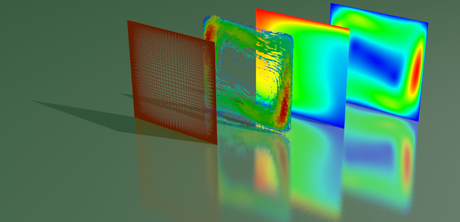CBSFLOW (2D)
CBSFlow 2d is a Finite Element Method solver for the Navier-Stokes equations, capable of addressing both incompressible and compressible problems.
The scheme underlying CBSFlow has been developed and applied to a wide variety of problems across the engineering spectrum. CBSFlow uses the characteristic-based split approach to convection stabilisation, with a fractional step approach to solving both steady and transient problems.

The methodology behind the CBSFlow software can be found in The Finite Element Method For Fluid Dynamics 7th Edition book, written by O.C. Zienkiewicz, R.L. Taylor and P. Nithiarasu.
Source codes are provided below for basic individual CBSFlow solvers. They are in individual packages as an aid to the user, as it will simplify understanding of the source code. These codes are provided as is, with no guarantee in accuracy or reliability of the code. All of the codes are under copyright, and no part of the code should be reproduced without written permission. These codes will be updated and enhanced in future releases.
Incompressible Solver - Semi-Implicit
- Implicit solution of the pressure field
- Banded Gaussian elimination solver
- Preconditioned conjugate gradient solver
- Linear triangular elements
- Output to Paraview or Tecplot formats
- Steady state or transient
- Local timestepping/Fixed timestep/Adaptive timestepping
- Natural/Mixed/Forced convection
- Optional energy calculation if not required
Click on the links below to download:
Checkout the Benchmark Section for Example Input/Output
Incompressible Solver - Fully-Explicit
- Explicit solution of the pressure field
- Uses artificial compressibility
- Matrix-free solution approach
- Linear triangular elements
- Output to Paraview or Tecplot formats
- Steady state or transient
- Local timestepping/Dual timestepping
- Natural/Mixed/Forced convection
- Optional energy calculation if not required
Click on the links below to download:
Checkout the Benchmark Section for Example Input/Output
Compressible Solver - Fully-Explicit
- Inviscid Problems
- Conservative form of Euler Equations
- Explicit solution of density field
- Matrix-free solution approach
- Linear triangular elements
- Output to Paraview or Tecplot formats
- Steady state only
- Iteration control: local/specified/minimum timestepping
Click on the links below to download:
Checkout the Benchmark Section for Example Input/Output
REMEMBER: If you want updated codes (with changelog information), provide your email address using the contact form here.
